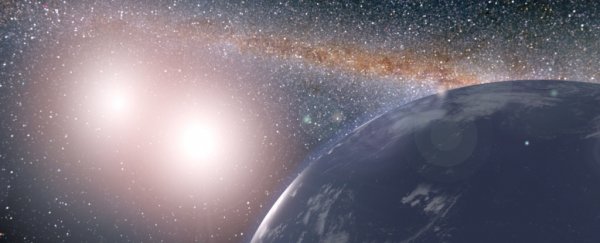We have precisely one data point against which to measure exoplanets for habitability: Earth. As far as we know, life has evolved only on this one pale blue dot, orbiting a single star in the middle of a spiral arm of an otherwise unremarkable galaxy.
Most stars in the Milky Way, however, are not like the Sun, hanging around in space all alone. Instead, up to 85 percent of stars may have at least one companion locked in mutual orbit (so it's nice that the Sun has us to keep it company).
This, naturally, complicates the search for life, since potential habitability is easier to assess around single stars. Binary companions bring additional gravitational interactions and stellar radiation to muck things up for any microbes attempting to squirm out of the primordial ooze.
A few years ago, astrophysicist Siegfried Eggl, now of the University of Illinois Urbana-Champaign and the University of Washington, devised an analytical framework for determining the habitable zones for binary stars, given these additional complications.
Now, he and his colleagues - Nikolaos Georgakarakos and Ian Dobbs-Dixon of New York University Abu Dhabi in the UAE - have applied that framework to known binaries hosting giant exoplanets, in a new bid to search for potential habitability.
"We used data collected by the Kepler spacecraft such as the mass of the stars, how bright the stars are, the location of a giant planet, and other parameters to create a methodology to identify systems with two suns that can host habitable Earth-like planets," Eggl explained.
The nine systems the team studied were all identified by the Kepler mission: Kepler-16, Kepler-34, Kepler-35, Kepler-38, Kepler-64, Kepler-413, Kepler-453, Kepler-1647, and Kepler-1661. These systems were all analyzed by the team using equations, rather than simulations, which are much more time-consuming.
"It's an analytic method that requires almost no computational effort whatsoever," Eggl said.
"There are some parts that use numerical models to feed in information, such as the way that the atmosphere interacts to different amounts and spectra of sunlight. That's really difficult to figure out analytically, so we used pre-computed atmospheric models for that.
"The benefit of our approach is that anyone can take our equations and apply them to other systems to determine where to best look for Earth-like worlds."
Of the nine systems, two were identified as particularly nasty. Kepler-16 and Kepler-1647 host giant planets too badly positioned to make for a stable habitable zone - a region where exoplanets are not so close to the star that surface water evaporates, and not so far that it totally freezes.
Kepler-16 already has a smaller habitable zone due to gravitational perturbations by the binary companion. In both systems, the giant planet makes the entire habitable zone dynamically unstable.
However, five of the systems could indeed have habitable worlds: Kepler-34, Kepler-35, Kepler-38, Kepler-64, and Kepler-413, with Kepler-38 being especially promising.
Even so, the conditions for habitability on any two-sun planet require a complicated balancing act.
"If a planet comes too close to its suns its oceans could boil away. If the planet is too far out, or even ejected from a system, water on its surface will ultimately freeze, as will the atmosphere itself, like CO2 that forms seasonal polar caps on Mars," Eggl explained.
"Once we confirm that a potentially habitable planet is on a stable orbit, we can proceed to investigate how much radiation it receives from the two stars over time. By modeling the evolution of the stars and planetary orbits we can estimate the actual amount or radiation the planet receives."
We know, thanks to the retired exoplanet-hunting telescope Kepler, that exoplanets can actually form in binary star systems, even with the added gravitational perturbations. The team's work shows that those exoplanets could possibly be habitable, too.
When searching for exoplanets that could host life, a wide net is desirable - but not if that wide net is going to be catching systems we know to be inhospitable. This new finding could help define the parameters for future work in looking for life outside our own wee pocket of space.
The research has been published in Frontiers in Astronomy and Space Sciences.
